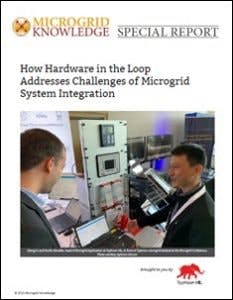In the fifth article of this special report series brought to you by Microgrid Knowledge and Typhoon HIL, we’re looking at how Hardware in the Loop (HIL) and model-based engineering (MBE) can streamline development of microgrids.
Get the full report.
The current approach to microgrid development tends to be disconnected, with various teams taking responsibility for the different stages of the development life cycle. The nature of the approach allows these groups to make decisions independently of each other, leading to error and inefficiency. Teams modeling the microgrid may not fully take into account the techno-economic assessment or the safety requirements of yet another group. Operational teams may not be consulted until it is too late to take their future maintenance issues into consideration.
Model-based engineering
Typhoon HIL promotes a model-based engineering approach to microgrids by representing the system as an integrated digital model, facilitating examination of system performance and archiving documentation. The integrated digital model can stay with the microgrid throughout its life cycle, from specification to operations, eliminating the risk of losing knowledge, decisions, drawings and documentation further down the microgrid’s life.
The MBE approach can streamline microgrid development. Existing Typhoon HIL schematics assist with the initial configuration; different components can be dragged and dropped from the library into the model to customize the system. At any stage, the designer can run a simulation of the system with generic or increasingly refined specific model parameters. The Typhoon HIL system allows portions of the virtual model to be interchanged with actual physical controllers running interactively “in the loop.”
An ultra high fidelity HIL simulation allows the teams involved with design, economics, safety, commissioning and operations to contribute to a single database or model of the microgrid and examine different aspects of system functionality in the bigger picture. In addition, model-based design simplifies communications between diverse design teams by virtue of being an executable specification. This means users can learn about the model by running it, especially if it is not initially clear what the model does.
Model-based design improves system integration by maintaining a single shared system model. In combination with C-HIL, it reduces project risk by providing the opportunity to simulate iteratively both the higher level system and more specific component behaviors as design details evolve through the microgrid development process.
Source: Typhoon HIL article. For more details, download the full report.
Specification
Defining the requirements from a microgrid and putting together a suitable specification at an appropriate cost to suit the customer’s needs is one of the early steps of every microgrid project. Rather than only showing drawings and documents of the microgrid configurations, it is possible to use Typhoon HIL’s MBE approach to create executable specifications or interactive digital models of the solution with varying levels of fidelity.
“Testing of interoperability in a C-HIL environment rather than a power lab with real high voltage equipment reduces costs and risks, and improves overall quality since the test coverage, or the number and range of tests, is significantly higher.” — Microgrid Knowledge Special Report, “How Hardware in the Loop Addresses Challenges of Microgrid System Integration”
Sales teams can use these dynamic replicas to demonstrate operational and financial benefits to prospective new clients. Sizing and virtual testing provides early realistic ROI and OPEX assessment, enabling smart investment decisions. Test driving the microgrid in this “flight simulator” months or years ahead of building the real microgrid can be a game changing, immersive experience for buyers and investors.
This is also an opportunity to address the increasing costs of energy storage and DER integration, recognizing that interoperability may become a problem later in the design cycle, as different devices may fail to “talk” to each other. Testing of interoperability can be carried out from day one. Doing this in a C-HIL environment rather than a power lab with real high voltage equipment reduces costs and risks, and improves overall quality since the test coverage, or the number and range of tests, is significantly higher.
Design and development
Testing continues as designs narrow down from the system level to the component level. This applies to new microgrids or the addition of components into existing systems. Typhoon HIL’s software provides an extensive library of industry-standard HIL compatible components, as well as HIL compatible physical controllers that can be plugged into the simulated environment, mimicking real life.
The design process begins by defining the specification, with accompanying tests, carried out continuously from the earliest design stages. The microgrid control and protection system can be interfaced directly with a high-fidelity model of the microgrid power stage and put through its paces by testing under faulty conditions. Model-based engineering and model-based testing reduces risk in later stages, such as commissioning, where additional days on-site can add significant costs to the project.
Assessing the behavior and performance in the virtual environment minimizes the risk of purchasing suboptimal and incompatible components. Also, testing all communication protocols, such as ModBus, IEC 61850 and IEC 614000, between any devices in the microgrid can eliminate interoperability issues.
Verification and commissioning
After testing the individual system components, going back up to the system level, Typhoon HIL’s C-HIL test bed can be used to carry out power automation testing. The real controller is connected to the simulated environment for testing under all faulty conditions, grid code and certification requirements. Physical controllers can be used to operate DERs and breakers, with their official software and firmware releases.
Precertification can be carried out in-house, prior to interaction with the certification body. Typhoon HIL has an extensive library of automated tests that can be used to validate the system against common standardized tests, such as IEEE 2030.8 and the Modular Energy Storage Standard (MESA).
Extensive testing will give confidence when entering the commissioning stage. Test coverage with a C-HIL test bed is an order of magnitude larger than lab based power tests. Unexpected system behaviors become less probable, and the process is more likely to run on time and to cost.
For a component manufacturer, it is beneficial to provide a prepackaged HIL compatible model to a system integrator, who can plug-and-play into the HIL simulation. This can make the design and verification process easier for a system integrator, as HIL compatible components and controllers can be prevalidated and precertified.
Maintenance
Typhoon HIL can support lifetime operations of the microgrid. It is plausible that the system will be expanded or upgraded through the addition of new components during its life. Without a digital model of the microgrid and HIL testing, guaranteeing these new components will integrate smoothly without creating unexpected faults is difficult.
It is possible, however, to set up the digital model in the HIL environment and run a digital twin. Any new components can be added to the digital twin, and extensive testing and validation can take place prior to physically adding the component. This de-risks the process and provides assurance to the microgrid operator.
The digital twin becomes “living documentation,” not only for future modifications and retrofits, but also for software updates that are often mandatory to maintain cybersecurity compliance. These can be trialed before rollout on the real system.
Next week, in the last of our special report series, we’ll look at some Hardware in the Loop case studies.
Catch up on the previous articles in the series here:
- Hardware in the Loop: Addressing the Challenges of Microgrid Systems Integration.
- Design and Validation of Microgrids.
- Hardware in the Loop HIL – Tried and Tested.
- HIL and Microgrids.
Download the full report “How Hardware in the Loop Addresses Challenges of Microgrid System Integration” courtesy of Typhoon HIL to learn more.







